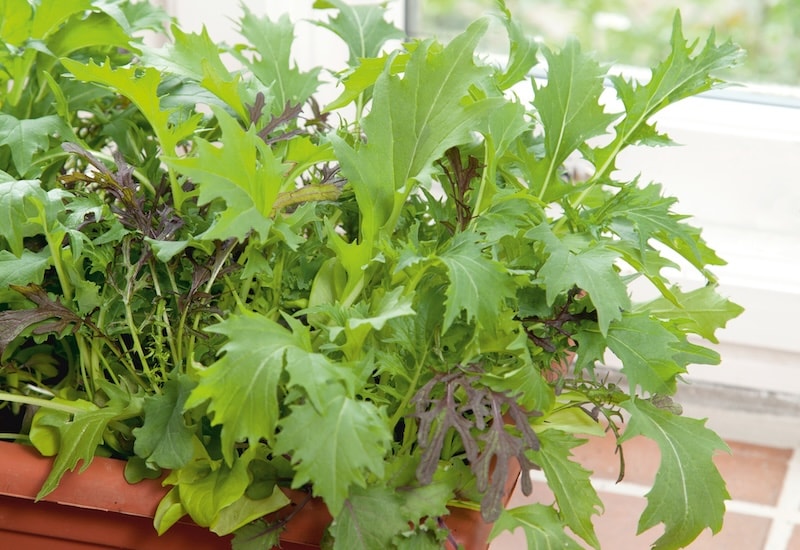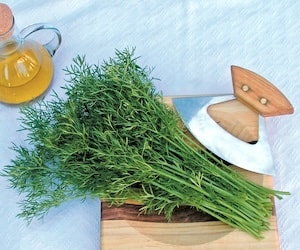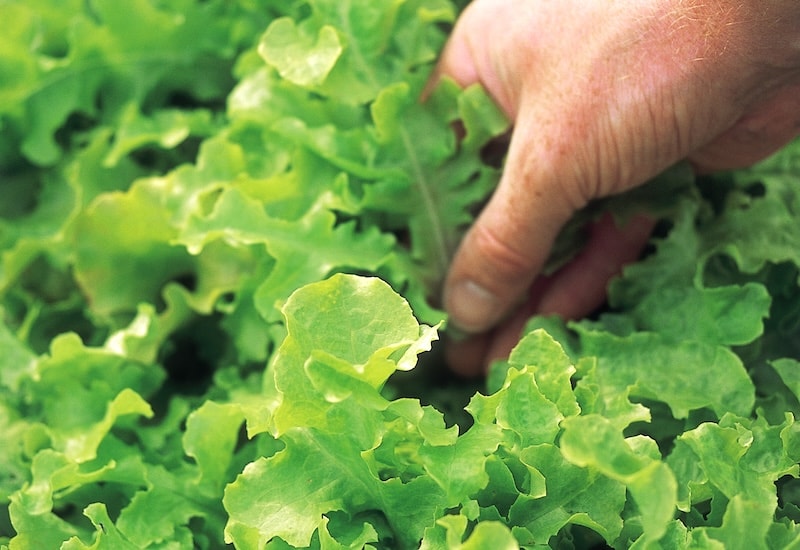Saving money by growing your own food is a great way to stretch your budget and, if you can, it’s always worth producing a little extra to give to friends and neighbours. The idea of bartering, swapsies and shares has long been a fundamental part of allotment-style growing. Whether it’s a few surplus vegetable plants left on a friend’s doorstep, or some freshly-picked fruit and veg for an elderly neighbour to enjoy, gardening writer Kim Stoddart has come up with four easy ideas for caring and sharing…
1. Sow extra trays of easy, fast-cropping plants

Image: Leaf Salad Winter Mix from Suttons
Cut-and-come-again leaves like lettuce, rocket and micro herbs grow easily and readily on a sunny windowsill and are very straightforward to germinate from seed. Radish also grows quickly so could be another useful plant to add in.
When you’re sowing your own seeds, why not start a few extra trays of salad leaves to hand out to friends, or pot up veg seedlings for them to grow on in their kitchens. You could reuse old plastic fruit and veg containers as pots.
Browse our full collection of windowsill gardening crops for more inspiration.
2. Create surplus produce

Image: Courgette F1 ‘Goldmine’ from Suttons
Come summer, most gardeners can attest to the fact that just a few courgette plants produce more than enough fruits for any one family to cope with. But this does make it an excellent choice if you want lots of extra produce to pass on. Runner beans are also very reliable and bountiful producers, and tomatoes can be as well, if grown in a sunny, protected spot.
I always recommend planting up as much as you can. As well as allowing you to give some produce away, it also opens up a whole new world of pickling, fermenting and preserve-making opportunities to feed you through the winter.
3. Take cuttings of the things that grow well

Image: Whitecurrant ‘White Versailles’ (Organic) from Suttons
Taking cuttings of the fruit and veg plants that thrive in your garden is a clever way to increase your harvests. It’s also a fantastic way of gifting plants to others.
You can take hardwood cuttings from soft fruit bushes like blackcurrants, redcurrants and gooseberries through the winter. Just snip away a roughly hand-length size cutting from a healthy-looking stem and place it in a pot, or bare patch of weed free ground so it can grow roots in spring. No rooting compound required.
4. Take advantage of self-seeding varieties
Some plants are quite capable of self-seeding readily on the veg patch, affording you with lots of lovely new seedlings with no effort at all! Most of the so-called weeds in my polytunnels are actually edibles created in this way. By allowing plants to complete their natural cycle you can also bag lots of no cost seedlings to pass around which are often perfect for windowsill pickings. Here are some of the crops that self-seed…

Parsley
This delicious herb can be a bit fiddly to germinate from seed, yet it will readily do the job itself once established. As a biennial, this means leaving the plant into its second year.

Calendula
This pretty flower has many uses around the veg patch, and its edible petals make an attractive addition to salads. It’s an enthusiastic reproducer, and will spread far and wide across your garden.

Nasturtium
For me, this edible plant (flowers and tangy, peppery leaves) is a climate change veg patch must-have. It grows in and around plants to help prevent soil drying out and also acts as a beneficial sacrificial plant against cabbage white caterpillar attack.

Rocket
This is a lovely peppery leaf that will self-seed with abandon given half the chance. Great for salads, pesto, pasta dishes and pizza toppings.

Coriander
With this zesty herb’s natural bolting tendencies, especially during the summer, simply allowing it to do what it wants will give you lots of free seedlings the following spring.
We hope this has inspired you to grow a little extra this year and share your bounty with friends, family and neighbours. Read our gardening advice articles over on our blog to help you grow bumper harvests.
Lead image: Lettuce ‘Salad Leaves’ from Suttons (©Branded Garden Products)
Last Updated on October 27, 2025 by Suttons Horticultural Team




